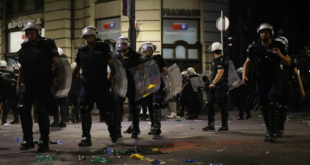 UNITED NATIONS (AP) – Armed conflicts have declined by 40 percent since the end of the Cold War primarily because the United Nations was finally able to launch peacekeeping and conflict-prevention operations around the world, according to a new study.
UNITED NATIONS (AP) – Armed conflicts have declined by 40 percent since the end of the Cold War primarily because the United Nations was finally able to launch peacekeeping and conflict-prevention operations around the world, according to a new study.
The first Human Security Report paints a surprising picture of war and peace in the 21st century: a dramatic decline in battlefield deaths, plummeting instances of genocide, and a drop in human rights abuses.
The only form of political violence that appears to be getting worse is international terrorism, a serious threat but one that has killed fewer than 1,000 people a year on average over the past 30 years. Tens of thousands were killed annually in armed conflicts during that time, said the report, which was financed by five governments and released Monday.
Despite the dramatic improvements in global security, the report warned against complacency, noting that 60 wars are still being fought around the world, including serious conflicts in Iraq and Sudan’s western Darfur region.
“The post-Cold War years have also been marked by major humanitarian emergencies, gross abuses of human rights, war crimes, and ever-deadlier acts of terrorism,” it said. “The risk of new wars breaking out – or old ones resuming – is very real in the absence of a sustained and strengthened commitment to conflict prevention and post-conflict peace building.”
Nonetheless, the report said there also was no cause for pessimism.
Andrew Mack, a professor at the University of British Columbia who directed the study, said the end of the Cold War eliminated tensions between capitalism and communism, cut off U.S. and Russian funding for proxy wars, and most importantly liberated the United Nations.
“With the Security Council no longer paralyzed by Cold War politics, the U.N. spearheaded a veritable explosion of conflict prevention, peacemaking and post-conflict peace-building activities in the early 1990s,” the report said.
A Rand Corp. study earlier this year concluded that the United Nations was successful in 66 percent of its peace efforts, but even the 40 percent success rate some believe is more accurate would be an achievement considering that prior to the 1990s “there was nothing going on at all,” Mack said.
“We think the United Nations, despite the many failures, has done in many ways an extraordinary job … very often with inadequate resources, inappropriate mandates, and with horrible politics in the council,” said Mack, who was the director of strategic planning in U.N. Secretary-General Kofi Annan’s office from 1998-2001. “If the politics were less horrible, the resources more adequate … the U.N. could do a much better job.”
According to the report, armed conflicts have not only declined by more than 40 percent since 1992, but the deadliest conflicts with over 1,000 battle deaths have dropped even more dramatically – by 80 percent.
Notwithstanding the genocides in Rwanda in 1994 and in the Bosnian town of Srebrenica in 1995, mass killings because of religion, ethnicity or political beliefs plummeted by 80 percent between the 1988 high point and 2001, the report said. The year 1988 was marked by the end of the bloody Iran-Iraq war and Saddam Hussein’s Anfal campaign, in which hundreds of thousands of Kurds were killed or expelled from northern Iraq.
Since the post-World War II era, the average number of battle-deaths per conflict per year – the best measure of the deadliness of warfare – has also been falling dramatically, though unevenly, the report said.
In 1950, the worst year, the average war killed 37,000 people directly, Mack said. “By 2002, it was 600 – an extraordinary change.”
The postwar period also saw the longest period of peace between the major powers in hundreds of years, and attempted military coups have been in decline for 40 years, the study found.
“Today most wars are fought in poor countries with armies that lack heavy conventional weapons – or superpower patrons,” the report said.
But a few high-tech wars have been fought by the United States and its allies since the end of the Cold War, first against Iraq to liberate Kuwait, then in Kosovo and Afghanistan where the huge military advantage led to quick victory and relatively few battlefield deaths.
“The current conflict in Iraq is the exception. While the conventional war that began in 2003 was over quickly and with relatively few casualties, tens of thousands have been killed in the subsequent – and ongoing – urban insurgency,” the report said.
Mack, who directs the Human Security Center at the University of British Columbia in Vancouver, said the report relies on new data from the Conflict Data Program at Sweden’s Uppsala University and other sources. He said its statistics were probably the best available but emphasized that decent data on wars and conflicts remained hard to obtain.
The report was funded by Canada, Sweden, Norway, Switzerland and Britain. Mack said a second report in 2006 will focus on the indirect costs of warfare.
 Eurasia Press & News
Eurasia Press & News



